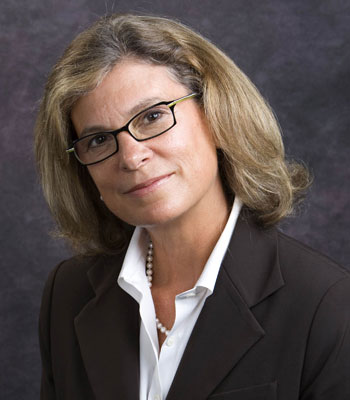Center targets ‘hidden health crisis’ of unhealthy workplaces
UC Berkeley's Interdisciplinary Center for Healthy Workplaces is connecting researchers in a variety of fields with businesses, agencies and nonprofits in a concerted effort to target what its director calls a "national health crisis."

February 6, 2014
A “mixer” usually doesn’t bring work to mind. But at a recent mixer on the UC Berkeley campus, work was all anyone was talking about.

Cristina Banks, director of the Interdisciplinary Center for Healthy Workplaces, wants to bring more science to the conversation about employee health and well-being. (Jim Block photo)
Sponsored by UC Berkeley’s fledgling Interdisciplinary Center for Healthy Workplaces (ICHW), the event brought together more than 50 researchers, business leaders, public policymakers and service providers who’ve taken an active interest in worker well-being. On their agenda: making new connections while exploring the ways work could be made a healthier, more satisfying and more productive experience.
Rates of diabetes, obesity and depression are on the rise for U.S. workers, and ICHW director Cristina Banks says she’s not surprised. As an industrial-organizational psychologist, she’s visited hundreds of workplaces and interviewed or observed thousands of employees over the last 40 years. Again and again, she’s seen workers too stressed out to eat properly, drink enough water or even go to the restroom. It’s a situation she calls “a national health crisis.”
“When I observe how people work, I see how unhealthy they are and how the way they work and the environment they work in is conducive to illness and injury and really debilitating wear and tear on individuals,” says Banks, a Haas School of Business senior lecturer.
“An unhealthy workplace can increase absenteeism, turnover, even medical issues that affect insurance rates and productivity,” adds Sheldon Zedeck, ICHW’s associate director. “It affects morale and job satisfaction, too. And that reaches out beyond the workplace and affects families. It has many tentacles.”
One incident Banks witnessed in person convinced her the time had come for action.
“I was observing somebody who was working as a manager in a restaurant, and she had this closet of an office where she had to do all her paperwork and emails on a tiny secretarial chair,” she says. “She was about 350 pounds and she fell out of the chair and got wedged in the doorway of her office. She was screaming, ‘I can’t get up! I can’t get out!’ That was a triggering event for me.”
Launch of the new center
Once back on campus, Banks was determined to bring the resources of UC Berkeley to bear on the problem. Working with Zedeck, a Berkeley psychology professor emeritus and former vice provost for academic affairs and faculty welfare, she launched the Interdisciplinary Center for Healthy Workplaces in 2012.
“We figured out that what we needed to seriously work on this was a center which could tap into all the science that’s being done at UC Berkeley,” Banks says. “When we looked into who else on campus was working on issues related to employee well-being and health, it turned out that there were about 20 different disciplines where researchers were investigating issues related to it. People in public health were studying it, public policy, environmental design, architecture, engineering, computer science, nutrition, law, economics and on and on.”
Banks and Zedeck recruited 18 of those researchers for ICHW through a series of informal breakfast get-togethers. More than 20 outside experts, including clinicians, agency directors, consultants and corporate executives, were brought into the mix as well. Eventually, their meetings evolved into what Banks calls “research sandboxes” —interdisciplinary brainstorming sessions designed to identify what is and isn’t known about what constitutes a healthy workplace.
Those discussions, in turn, led to the development of research projects on a number of related topics, such as how to improve conditions for blue-collar workers and the impact of “open office”-style office design. ICHW will soon begin actively seeking funding for the research projects.
Interdisciplinary focus
In the meantime, Banks and Zedeck decided to expand the sandboxes to include even more outside input. The result was the mixer, which was held at the University Club atop California Memorial Stadium. Representatives from Google, Safeway, Kaiser Permanente and other companies that have launched innovative employee wellness initiatives offered presentations on their efforts and findings.
Christine Baker, director of California’s Department of Industrial Relations, and Dr. L. Casey Chosewood, manager of the National Institute for Occupational Safety and Health’s Total Worker Health program, briefed attendees on the impact of unhealthy workplaces from a public policy perspective.
“The industry is ripe for this kind of interdisciplinary focus on wellness,” says mixer participant Rebecca Ruggles, who designs hospitality and health and fitness projects for international architecture and consulting firm Gensler. “Having some proven research as backup for our wellness recommendations to our clients is extremely valuable. It’s also great to tap into the wider network that the center has and create some new professional connections in the Bay Area.”
Ruggles doesn’t appear to be alone in that opinion. According to Banks, one of the first action items the mixer’s attendees requested was more mixers. She expects the next one to be held in June. Soon after, she’s hoping, ICHW will throw its net even wider and bring in experts from around the world for an international conference.
“I see the potential here for having a global impact,” Banks says. “Berkeley being Berkeley, the hub of a lot of international inquiry and relationships across academic fields, we could be the one-stop shop for any organization in the world that’s saying, ‘What do we know about employee health and well-being? What do we know about the creation of healthy workplaces?’
“We will be the repository,” adds Banks, “for all the best science available.”